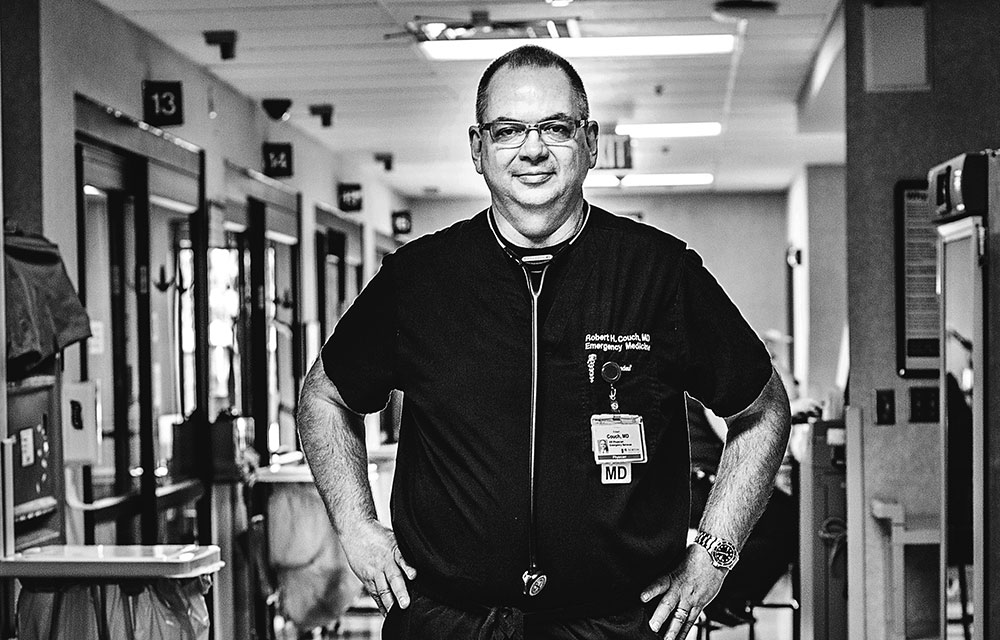Photo by Mickie Winters
August 30:
The first of them came in around 3 p.m. Three, maybe four men. After everything that happened that day, it’s hard to remember which patients arrived together. In a sense, they were all together. All 24 of them, united by heroin.
Charge nurse Stephanie King thought the men looked OK, considering — they were awake, mostly aware, one of them asking repeatedly what had happened. EMS had already administered opioid-reversing drugs like Naloxone and the name-brand Narcan, restoring the men from unconscious stupors that were almost death poses. But their livers were still metabolizing the heroin, and if the good drugs wore off before the bad ones, they would fall back into oblivion.
The oldest of those first few patients was 65. He told Dr. Robert Couch that he’d split $15 worth of heroin with two friends, both of whom had been using for decades. He could not believe that such a small dose had nearly killed him. Over the next three hours, 12 more heroin overdose patients crowded the ER, some awake from the treatment they received in the field or in an ambulance — the life-saving drugs injected or even applied intra-nasally — some slumping and unconscious from a friend’s car. King had seen overdoses before — they’ve happened in the parking garage, even in the bathroom in the waiting room — but this was unprecedented. Couch had never seen anything like it in his decades working in emergency departments and as a paramedic. The most overdose patients he’d treated in a shift was three. On the day Louisville OD’d, he tripled that.
This stuff was different. It may have been cut with an opioid called fentanyl, though exactly what was in the heroin remains unclear. Doctors only test for broad categories of drugs — amphetamines, for example, or opioids — and they prioritize treatment over testing, so the specifics haven’t been pinned down with certainty.
The staff played Tetris with beds, rolling stable patients into hallways to make room. Still, they were overwhelmed. King kept looking over to check on the woman stuck in the lobby. Her dialysis would have to wait.
In one of the beds, mascara streamed down a young black woman’s cheeks. “I was dead,” she said. “I was dead.”
Couch held a press conference to warn people about the especially dangerous heroin. He sat down with Louisville Magazine to share his experience of that night and his expertise on the drug epidemic. Read on for excerpts of what he told us.
“When people say, ‘Describe a heroin user,’ I tell them, ‘Look around. That’s what they look like.’”
“Probably what’s up with what’s on the street right now is that it’s very toxic. It is taking big does of Naloxone to reverse it sometimes.”
“In the emergency department, we deal every day with heart attacks and strokes and pneumonia and just garden-variety general illness. But when something predominates, it gets your attention pretty quickly. And that was the case with the heroin.”
“There have been about 250,000 people who have died in the last 15 years from opioid overdoses. Which is about the same number of people who died starting in the mid-’80s…when HIV started. The epidemic is of the same magnitude.”
“It really affects everybody, because these people get involved with the criminal justice system, they’re overwhelming jails. And, actually, the largest detox facility in Jefferson County right now is Metro Corrections because Mark Bolton, who runs the jail, is running a detox center down there.”
“It’s not just treating the overdose; it’s treating everything that goes along with it. So HIV and hepatitis C are concerns. We see a lot of people in the emergency department who come in with skin abscesses, with (treatment-resistant infections). They come in with bacterial endocarditis. I just saw a patient within the last few days who — IV drug abuser, heart valve got infected, had to have valve-replacement surgery, long-term antibiotics. It can cost $100,000 to treat them. One person. And that’s assuming they don’t spread their HIV or hepatitis C to anyone else.”
“The solution to this problem is going to require so many people coming from so many directions. It’s not, ‘Well, we’re gonna pass stronger drug laws.’ That’s not going to solve the problem. We can’t incarcerate ourselves out of this problem.”
This originally appeared in the October 2016 issue of Louisville Magazine. To subscribe to Louisville Magazine, click here. To find your very own copy of Louisville Magazine, click here.



